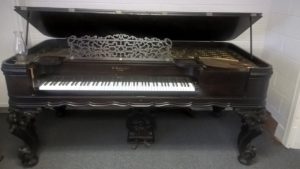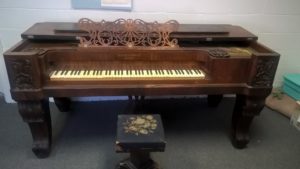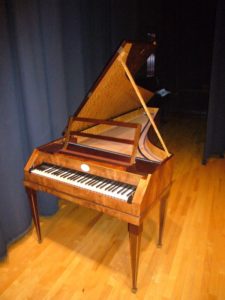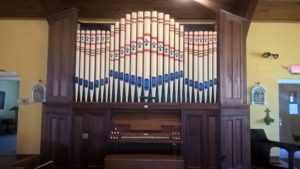Wesley Roberts
Campbellsville University is pleased to have been chosen as the host institution for the recently created Vogt-Farrar Historic Keyboard Collection. This historic collection of keyboard instruments began in August 2011 when Doris Vogt Farrar and Lloyd Farrar donated the first of six instruments which would come to the University over a three-year period. During these years the collection grew to include a Steinway grand piano, three nineteenth-century square grand pianos, a fortepiano, and a small pipe organ. Retired musicians and educators, the Farrars’ hobbies included collecting nineteenth-century keyboard and brass instruments made in the United States.[1]
The idea to donate the keyboard portion of their collection to Campbellsville University originated with their son Mark Farrar, who was a cellist in the Campbellsville University Orchestra. On his parents’ behalf, Mark asked orchestra director Robert Gaddis if the School of Music would be interested in his mother’s Steinway grand piano. Never one to turn down a good donation, Dr. Gaddis recruited piano professors William Budai and Wesley Roberts for a trip to the Farrar family home in Norris, Tennessee during the summer of 2011 to assess the Steinway and to view several square grand pianos. This trip started a friendship that opened the opportunity for other gifts that would eventually form the Vogt-Farrar Historic Keyboard Collection.
The first gift was a Steinway Model L grand piano built in 1927. It had been sold the same year by the Aeolian Company of Missouri in St. Louis to Miss Viola Mae Kurrus, a member of the Vogt family, for $1,525. The piano later passed along to Doris Vogt Farrar, who used it as a working instrument, teaching countless piano lessons over the course of some forty years. In 1991 it was restored to its original specifications by Gaithersburg Piano Craft, Gaithersburg, Virginia. The end result was a historically-preserved piano that happily met the expectations of the family. Upon its arrival at Campbellsville University, the piano was placed in one of the university’s piano studios where it has since received daily use. A dedication concert for the piano was given on March 22, 2012 by Wesley and Sida Roberts in Gheens Recital Hall. The performance included Amy Beach’s Summer Dreams for piano duet, a work that Doris Farrar had found at the Library of Congress and assisted in its publication by Kjos Music.
The Vogt-Farrar Historic Keyboard Collection displays three examples of nineteenth-century piano manufacturing in the United States before and after the Civil War. While many cities hosted piano builders, Baltimore played a key role in piano building during the period. Located south of the Mason-Dixon Line, most square grands built in Baltimore (sometimes called “table” or “rectangle” grands) were done by manufacturers within a few blocks of one another. Business directories for Baltimore list 103 piano makers between 1799 and 1859. One of the longest running firms in operation from this era is Knabe, which now operates through Samick Music Corporation. Knabe was founded by German-born William Knabe (1803-1864), who immigrated to the United States in 1833 and began building pianos in Baltimore in 1835. Around 1838 he partnered with William Henry Gaehle to build pianos for approximately sixteen years until Gaehle’s death in 1854. Following Gaehle’s death, Knabe resumed building pianos under his own name. The Knabe and Gaehle partnership was made famous when Francis Scott Key, author of The Star-Spangled Banner, commissioned a piano from the firm for his home.[2]
The oldest square grand in the Vogt-Farrar Collection is a Knabe and Gaehle, built circa 1846. It has a six-octave keyboard (seventy-five keys; the standard nowadays is eighty-eight) and is in an unadorned case of rosewood veneer with orange shellac finish. Space is provided for a lamp on the left of the music stand. Significantly, it was constructed using an early application of a half iron plate with iron strings, all stretched in the same direction without overlay. In its day the instrument would have been tuned to A=450-452 Hz. The piano is accompanied by a red stool dating from the final third of the nineteenth century.

Knabe and Gaehle Square Grand Piano, circa 1846
Contemporary with Knabe and Gaehle was another Baltimore firm established by George Eggert and Charles Bobeth. Eggert and Bobeth had worked briefly for Knabe before their joint operation and Bobeth would continue to have a hand in the production of Knabe’s pianos at least into the 1880s. The Vogt-Farrar Collection includes the only surviving Eggert and Bobeth square grand.[3] This instrument dates from circa 1852-54 and has a seven-octave keyboard (eighty-five keys). It has a full light iron plate with all the strings stretching in the same direction without overlay. Its ornate legs and music stand are in a light brown casing. There are platforms for lamps on both sides of the music stand. The instrument was owned by Robert Mercer Taliaferro Hunter[4] (1809-1887) of “Fonthill” near Lloyds, Virginia. Hunter was elected a United States Representative and served a two-year term as Speaker of the House before being elected a United States Senator. He purchased the piano for the education of his four daughters. The piano is believed to have been in the family’s possession for three-quarters of a century. Hunter joined the Confederacy at the outbreak of the Civil War and became the Confederate Secretary of State and later a Confederate Senator. Following the war he was state treasurer of Virginia. A photo of Hunter is displayed with the piano.

Eggert-Boeth Square Grand Piano, circa 1852-1854
The most impressive of the three square grands is by William Knabe. It was built circa 1885 and housed in a dark wooden case of either mahogany or walnut with an opaque shellac finish. It has a massive cast iron plate produced under a patent owned by Knabe with drawn steel strings. At the time this was a significant development in piano building. A huge instrument, it is completely finished on all four sides; earlier instruments, including the two discussed above, were typically three-quarters completed with the back side left unfinished to rest against a wall. Legend has it that this Knabe was used as a concert instrument at Peabody Conservatory of Music in Baltimore. It would have been set on stage at a 45-degree angle with the back of the instrument and the performer’s face partially turned toward the audience. The instrument has ornately curved legs and music stand with a seven-octave keyboard (eighty-eight keys) and platforms for lamps on both sides of the music stand. The strings are overlaid in two directions and were tuned to A=446 Hz. Although none of the three square grands in the collection are currently playable, they show the remarkable evolution of seventeenth and eighteenth century craftsmanship based entirely on wood construction contrasted by the late nineteenth century mixing of massive iron and steel parts in large wooden bodies.

Knabe Square Piano, circa 1885
The square grand pianos are currently housed in a special room in the Gosser Fine Arts Center. Each one has a damper pedal and an una corda pedal[5]. Tuning principles changed significantly over the nineteenth century on the east coast of the United States and varied according to the types of pianos and organs being produced. This produced a large variance in pitch as described in these three square grands. Photos and drawings of contemporary musical events and personalities are displayed with the pianos, including a portrait of Robert Mercer Taliaferro Hunter and a little known photo of the Souza Band taken in Willow Grove Park, Willow Grove, Pennsylvania in 1920. Period artifacts are included as well, such as lamps, candles, and stools. A small pump organ made by Kimball in Chicago in 1880 was added to the collection in 2013 by Joan Majors of Louisville. This instrument possesses nine stops of various types along with couplers, and is a prime example of pump organs built in the late nineteenth century.
As the collection grew in size, Lloyd Farrar determined that a fortepiano should be added to show the progression of stringed keyboard instruments from the harpsichord to the piano. By the late eighteenth century, the fortepiano was the favored piano in Vienna, Austria, a center of its production and concertizing. In May 2013, the Farrars purchased a replica of a 1790 Anton Walter fortepiano built in 1995 by Thomas and Barbara Wolf of The Plains, Virginia. The Wolfs are contemporary builders of replica pianos, fortepianos, and harpsichords who strive for historical authenticity in their recreations. Walter (1752-1826) was a well-known Viennese fortepiano maker of German birth. The Wolfs’ replica of Walter’s instruments was the fourth of nine they made. It is an amalgamation of four to five slightly different styles by Walter and is exceptionally ornate. It has a five-octave keyboard, bone keys, trichords in the upper register, copper shingles in the lower register, and is tuned to A=430 Hz. Wolfgang Amadeus Mozart purchased a Walter fortepiano not long before his death, and Ludwig van Beethoven owned one in his early years. The donated replica had been used as a concert instrument by Andrew Appel, Artistic Director of the Four Nations Ensemble, along the East coast from Washington, D. C. to Boston[6]. It is of superb quality and has been used in concerts at Campbellsville University since its acquisition.

Fortepiano, 1790 replica
Shortly after receiving the fortepiano, the Farrars donated a one-manual, mechanical action Pomplitz organ to the university. Lloyd Farrar had learned that the organ was being discarded years ago and could not bear to let such a thing happen. Built in Baltimore by the Pomplitz Church Organ Company in 1875, this ten-rank instrument was numbered 185 and carries the names J. W. Otto and C. Melbert on its nameplate. It has a 61-note keyboard and a 27-note pedalboard. Its stoplist consists of Open and Stopped Diapasons 8, Melodia, Salicional, and Dulciana 8, Principal and Rohrflute 4, Fifteenth 2, Twelfth 22/3, and for the pedals, Bourdon Bass 16. A manual to pedal coupler is provided (hand drawn) and two foot levers to add or cancel five stops simultaneously. The organ is tuned to A=456 Hz, the standard tuning for organs in its day. A slider chest action is used and the original hand pump for the bellows was preserved. In order to make the instrument more useable to the university, a quiet .45 hp Venus blower by the German firm Aug. Laukhuff was installed.
The organ’s maker, August Pomplitz (1825-1877) was born in Prussia and immigrated to the United States, settling in Baltimore where he began a manufacturing business with Henry Rodewald in 1851. Together, the two built organs under the name Pomplitz and Rodewald until 1862, when in the midst of the Civil War, Rodewald withdrew from the company and Pomplitz continued under his own name. His son Herman, widow Louisa Otto Pomplitz, and her brother John Otto assumed some operation of the company around the time of August’s death in 1877 and continued operation until circa 1883. Approximately 225 organs were built by the Pomplitz Organ Company; most were put into service in the mid-Atlantic region.[7] Of this number, fewer than a dozen survive today.
The Pomplitz organ in the Vogt-Farrar Collection initially served a Methodist church in Harrisonburg, Virginia, and was moved to the African Methodist Episcopal Zion Church in Cumberland, Maryland around 1910 before being dismantled and acquired by the Farrars. Once the Farrars decided to donate the organ to Campbellsville University, they employed Brad Rule and Company of New Market, Tennessee to restore the instrument. Although the organ had been dismantled and in countless pieces while in the Farrars’ possession, Rule was able to restore the instrument using the appropriate historic principles without a diagram. His work was completed in 2012-13 and the organ was delivered to Campbellsville in May 2013. The size of the instrument made its installation in Gosser prohibitive. It was installed in Our Lady of Perpetual Help Catholic Church, which is next door to Gosser Fine Arts Center. The university and church share in using the instrument. Students practice and take lessons during weekdays while the congregation uses the organ for its worship services.
The original casing for the organ was not preserved and as work progressed on the organ’s restoration, the Farrars engaged their carpenter friend, Timothy Snow of Knoxville, to create a case which would complement the interior of Our Lady of Perpetual Help. Snow’s work, along with a baseboard created by Campbellsvillian Tom Lyons, resulted in a beautifully crafted organ case. A façade of twenty-seven pipes was installed by Rule, to which Campbellsville University art student Luisa Martini from Venezuela was engaged to design and paint. Stop-face design was done by Peggy Smith of Sevierville, Tennessee. The final result was a beautifully crafted organ which pleased both the university and church parishioners and acoustically fit the room very well. A dedication concert was given by Wesley Roberts on September 17, 2013 and the organ was blessed the following month during Mass on October 13 by Rev. James M. Reinhart, Pastor.

Knabe and Gaehle Square Grand Piano, circa 1846
By making these keyboard instrument donations, Lloyd and Doris Vogt Farrar created a legacy which has since been enjoyed by students, faculty, guest musicians, and the Campbellsville community. Lloyd and Doris Farrar met as undergraduate students at the School of Music, University of Illinois, Urbana-Champaign. Doris studied piano performance while Lloyd studied instrumental performance, conducting, and musicology. They observed their sixtieth wedding anniversary on September 1, 2016. In their six decades together, they have performed and taught in Illinois, Kansas, Texas, Virginia, and principally in the Maryland suburbs of the District of Columbia. In the latter location they availed themselves to the Music Division of the Library of Congress for research in their chosen fields. For Doris this meant discovering and spreading the lost works of Amy Beach, a pioneer American female composer. As a musicologist, Lloyd became active in uncovering the history of crafting and manufacturing musical instruments in the United States. His study “The Fife and Its Makers in the United States of America” is a basic reference in that obscure field. He also coordinated a committee that submitted approximately six hundred detailed articles to the New Langwill Index: A Dictionary of Musical Wind-Instrument Makers and Inventors (1993). His collection of approximately five hundred American historical band instruments as well as his library and research files are in the process of being transferred to the Souza Archives and Center for American Music at the University of Illinois, Urbana-Champaign.
Two other keyboard instruments on the campus of Campbellsville University complement the Vogt-Farrar Collection for their historical value. These are a two-manual Challis harpsichord and a three-manual Farrand and Votey pipe organ. John Challis[8] (1907-1974) was an American builder of harpsichords who incorporated a significant amount of metal in his harpsichords. This instrument was commissioned by Doris Bickel (1918-2007), a renowned professor of piano and harpsichord who taught at the University of Louisville for several decades. It later came into the possession of Dr. Polly Cooms of Louisville, from whom Campbellsville University purchased it in 2015. This harpsichord possesses 16’, 8’, 4’, Nasale, and Harp stops.
The Farrand and Votey pipe organ was purchased in 2003 and installed in 2007 in the newly completed George W. and Marie T. Ransdell Chapel on the university campus. The instrument was originally installed in Christ Church Cathedral in Nashville in 1894. It consisted of approximately fifteen ranks and in the decades that followed was enlarged by Moeller, Pilcher, and Milnar Organ Companies. Upon its purchase the university engaged Milnar Organ Company to convert the console to solid state, rebuild and redesign certain features, move and install the instrument into Ransdell Chapel. A zimbelstern and a set of trompette-en-chamade were donated upon installation, advancing the organ to fifty-one ranks.[9]
The Vogt-Farrar Historic Keyboard Collection provides a broad view of keyboard instrument building in the nineteenth century which enhances our understanding of instrument manufacturing and performance during this epoch. Collections may be an assemblage of objects that are interesting each in themselves or they may be a gathering of objects that gain in cultural and historical meaning by being displayed. It is the donors’ desire that this collection becomes a teaching laboratory in a liberal arts environment such as Campbellsville University. And, indeed, it has.
[1] The author gratefully acknowledges Lloyd Farrar’s insightful comments about the instruments and their makers described in this article.
[2] Wm. Knabe & Co., “History,” Knabepianos.com, http://www.knabepianos.com/ [accessed October 27, 2016].
[3] One other Eggert and Bobeth is said to survive but has not yet been confirmed.
[4] U.S. Congress, Joint Committee on Printing, “Hunter, Robert Mercer Taliaferro, (1809-1887),” Biographical Directory of the United States Congress, 1774-Present, http://bioguide.congress.gov/scripts/biodisplay.pl?index=H000988 [accessed October 27, 2016].
[5] The soft pedal of a piano is called the una corda pedal. It is standard on all modern pianos. It is generally the leftmost pedal among the piano’s three pedals. It primarily modifies the timbre and color of the tone as well as the volume of the tone.
[6] “Andrew Appel, harpsicord and fortepiano,” The Four Nations Ensemble. http://www.fournations.org/appel.htm [accessed October 27, 2016].
[7] “The Pomplitz and Rodewald Pipe Organ,” South Mountain Heritage Society, Burkittsville, MD. http://www.southmountainheritagesociety.org/ [accessed October 27, 2016].
[8] Howard Schott, “Challis, John,” Grove Music Online, Oxford Music Online, Oxford University Press. http://www.oxfordmusiconline.com/subscriber/article/grove/music/05373 [accessed October 27, 2016].
[9] For more information on the history and construction of this instrument, see Wesley Roberts’s “Farrand and Votey Organ Installed in Ransdell Chapel,” The Campbellsville Review 3 (2005-2007): 11-20, reprinted in The Diapason 198 n1 (September 2009): 23-25, and available online at: www.campbellsville.edu/farrand-and-votey-organ-installed-in-ransdell-chapel.
Wesley Roberts is professor of Music, Campbellsville University. A member of the faculty since 1982, he emphasizes piano and musicology. He is co-author, with Maurice Hinson, of Guide to the Pianist’s Repertoire, published by Indiana University Press.
